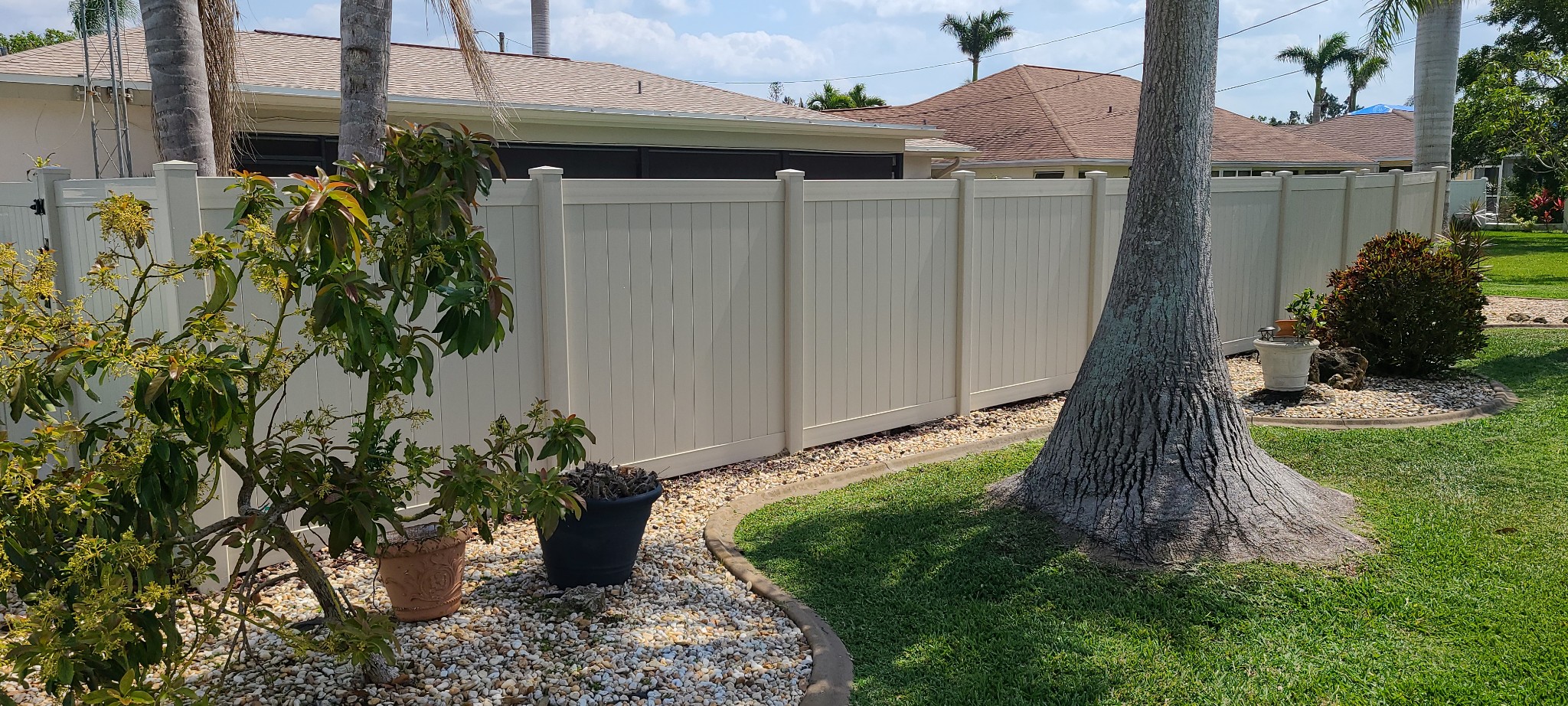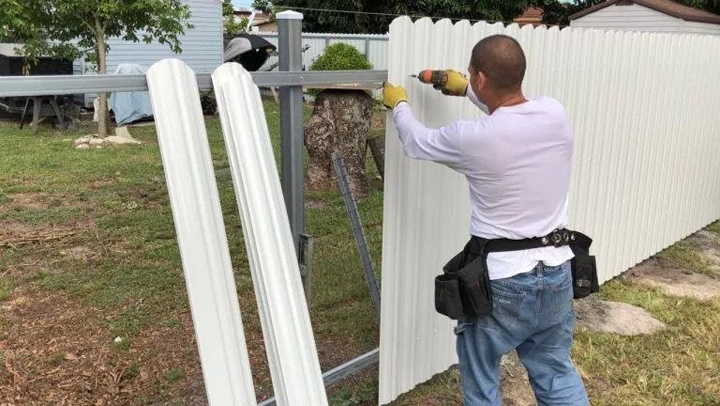Garden fencing is pivotal in yard design, serving practical and aesthetic purposes. It defines property…

Can My Neighbors Paint Their Side of My Fence? Here’s What You Need to Know
Have you ever woken up to the shocking sight of your backyard fence suddenly donning a new shade because your neighbor decided to give it an impromptu paint job? Or maybe you’ve been wondering, in anticipation of such an event, what the laws are regarding this boundary issue. Either way, your question is: “Can my neighbors paint their side of my fence?” It’s a valid concern and one that’s seen countless instances like the Great Jones vs. Smith Fence War of ’08 in our local area—where Jones woke up to bold fuchsia stripes on her once white picket fence. Fortunately, we’ve compiled the legalities and considerations surrounding this matter—one that oddly fuses property rights and artistry—to shield you from any unwelcome surprises.
Generally speaking, your neighbor cannot paint their side of a shared fence without your permission if it falls on your property line. If they do so without your permission, they may be liable for vandalism. However, it’s always best to consult with a solicitor to clarify the specifics of local laws and requirements for dividing fences in your area.
Understanding the Legality of Fence Painting
When it comes to fence services such as painting, fence removal, o replacement, many homeowners are unsure of their legal rights and obligations. While you may have strong feelings about how your fence should look, it’s important to understand the laws and regulations that govern property boundaries and ownership.
One thing to keep in mind is that your neighbor cannot paint their side of your fence without your permission unless their side of the fence falls on their side of the property line. In this case, they are free to paint as they please since the fence legally belongs to them. On the other hand, if the neighbor paints your side of the fence without your consent when it falls entirely on your property line, then they could be sued for vandalism.
It’s also worth noting that understanding property boundaries is crucial before building a fence. Before beginning any construction, it’s best to consult a solicitor or lawyer for clarification on the requirements for building dividing fences. This can help avoid any unexpected legal issues down the road.
Additionally, seeking legal advice may be necessary if there is a dispute over who owns the fence or if there are questions about maintenance responsibilities. Legal disputes can be costly and time-consuming, so it’s essential to get everything in writing and have a clear understanding of all relevant laws and regulations.
However, some may argue that too much emphasis is placed on legality instead of simply being a good neighbor. While following legal guidelines is essential, it’s also important to prioritize open communication and finding mutually acceptable solutions.
With that said, let’s explore in more detail how property lines and ownership play a role in the legality of fence painting.
Property Lines and Ownership
Unsurprisingly, property lines play a significant role in determining who has the right to paint a given section of a shared fence. In general, whoever owns the fence has the right to control how it looks, but things can get tricky when the fence falls partially on both properties.
For example, if your side of your neighbor’s fence falls entirely on your property line, then you have the right to paint it. However, if your neighbor owns the fence and wants it to remain a certain color, it’s best to keep them in the loop and promise to do an excellent job at painting your side.
On the other hand, if your neighbor’s side of the fence borders on your property but doesn’t touch your property line, then they have full control over how it looks. Attempting to paint their side without permission could lead to legal disputes or strained relationships.
Furthermore, if you’re considering building a new fence alongside your neighbor’s existing one, you’ll need to ensure that you don’t encroach on their property. This could create confusion about ownership and maintenance responsibilities down the road. Be sure to consult with a professional before beginning any construction.
Think of a shared fence as a shared wall in an apartment building – while you may live next door to each other, certain parts of the building belong exclusively to one unit or another. In order to avoid disputes over who has access or control over certain areas, it’s important to establish clear boundaries and expectations from the outset.
Now that we’ve explored the role of property lines and ownership in fence painting legality let’s move on to discussing local and HOA regulations relating to fence maintenance and appearance.
- When it comes to painting or repairing a shared fence, knowing the property lines is critical. The owner of the fence usually has the right to control how it looks, but situations can become complicated when the fence falls partially on both properties. If your side of the fence lies entirely on your property line, you have the right to paint it. On the other hand, if your neighbor’s side of the fence borders your property but doesn’t touch your property line, they have full control over how it looks. Before starting any construction, ensure that you don’t encroach on your neighbor’s property. In order to prevent disputes over access and control, it’s crucial to establish clear expectations and boundaries from the outset. Finally, understanding local and HOA fence maintenance and appearance regulations is essential.
Local and HOA Regulations
When it comes to fences, local and HOA (Homeowners Association) regulations can differ greatly. It’s essential to research your city or county guidelines regarding fence installation and upkeep. Some cities will have specific height restrictions for fences, while others may prohibit certain types of materials from being used.
HOAs often have their own set of rules when it comes to fences. Some may require that all fences within the community be the same color or style, while others may prohibit fences altogether. It’s important to review the CC&Rs (Covenants, Conditions & Restrictions) of your HOA and attend meetings to ensure you’re aware of any changes or updates to their fence policy.
One homeowner in Arizona learned this lesson the hard way when he was fined $100 per day by his HOA for repainting his side of a fence without approval from the association. The association claimed that they owned the fence and had a specific color scheme in place for all fences within the community.
Additionally, some cities may require a permit for any structural additions, including fences. Depending on where you live, you may need to obtain approval from the city before installing a fence. Be sure to do your due diligence and research your local laws before proceeding with any fencing project.
In a small town in Indiana, one couple installed a six-foot-tall wooden privacy fence around their backyard, only to receive an order from the city requesting that they remove it entirely. Upon further investigation, they learned that their city had strict zoning laws regarding fencing and that their new fence did not meet the guidelines.
Failure to comply with local or HOA regulations can result in fines or even legal action taken against you. In some cases, you may be required to remove or modify your fence entirely.
With that said, it’s crucial always to keep the lines of communication open with your neighbors and local authorities regarding your fence.
Navigating Neighborly Disagreements Over Fence Painting
Fence painting can often lead to disagreements between neighbors, but it doesn’t need to be that way. When discussing fence painting with your neighbor, remember to approach the conversation calmly and kindly.
Consider this scenario: if your neighbor rented out their basement as an Airbnb and held loud parties every night, you would likely approach them politely and ask if they could keep the noise down. Approach fence painting disagreements in the same manner – with kindness and respect.
In one instance, a woman in California was frustrated when her neighbor painted his side of her newly-installed wooden fence without asking for permission first. After a tense exchange, the two were able to come to an agreement and decided to split the cost of repainting both sides of the fence a neutral shade.
While there are no known laws that prohibit painting your side of a neighbor’s fence, it’s important always to acknowledge the ownership of the fence. Some may argue that if the fence is on your property line, you have the right to paint it without seeking permission from your neighbor. However, it’s best to discuss any changes to the fence jointly and ensure both parties agree on a solution.
In cases where compromise cannot be reached, legal action may be necessary.
- According to a survey conducted by the HomeOwners Alliance in the United Kingdom in 2019, as many as 1 in 3 homeowners reported having some sort of property line dispute with their neighbor, including conflicts over fencing.
- A study published by the American Bar Association found that roughly 2% of property disputes between neighbors result in a lawsuit, which can include conflict over changes made to a shared fence.
- Statistics from a survey conducted by legal services firm Avvo revealed that 15% of Americans have ongoing issues with their neighbors concerning property boundaries and related rights like painting fences.
Starting the Conversation
When it comes to fence painting, approaching your neighbor cordially and presenting a reasonable proposal is crucial. A friendly chat can go a long way in preventing disputes about fence painting that could lead to legal action. Before having this conversation, it’s important to know what you are asking for, so research well and come prepared with information about your local regulations and HOA guidelines.
It’s understandable to feel protective of your property and its appearance. Remember that your neighbors may also have concerns and feelings about their property. Starting the conversation by approaching your neighbor in a friendly manner is important. It would help if you make it clear why you want to paint the fence, such as improving its aesthetics or even maintenance purposes.
For instance, if you are looking to paint the fence due to maintenance issues, like applying waterproofing materials or sealing agents, share this information with them. They could appreciate this gesture since maintaining a sturdy fence benefits all parties involved.
You should also keep in mind that not all neighbors will agree with your proposed fence paint color. Be open-minded about their opinion, ask questions, and find opportunities for compromise. You might be able to find middle ground on something else that works for both parties and aligns with the HOA guidelines or local laws.
In the end, it’s essential to approach the conversation without presumptions or accusations towards either party. Being respectful goes a long way in fostering positive relationships within the community.
With that in mind let’s take a deeper dive into finding compromises when it comes to fence painting.
Finding a Compromise
Finding common ground when it comes to fence painting agreements can sometimes prove challenging but ultimately rewarding for both parties involved. After establishing communication lines with your neighbor regarding your desire to update or maintain the fence shared between your properties, finding common ground is critical.
One solution could be to split the cost for painting the fence or hiring a fencing contractor to do the job. This way, both parties contribute equally to a professional and attractive outcome, addressing concerns about property lines and limiting potential legal disputes.
For example, suppose you choose to take on the responsibility of redoing the fence entirely. In that case, you could consider using materials that blend well with each other while ensuring that your neighbor’s preferences are taken into account as well. Vinyl fences have been known to be low-maintenance options, making them more convenient for both parties.
If your neighbor doesn’t prefer your proposed color option or alternative materials, find other ways to compromise by keeping their input in mind. You could consider incorporating their yard’s style and colors into your design proposal for the fence. Ultimately, these shared design ideas may end up improving the neighborhood’s look altogether while still fulfilling your initial goal.
However, there are times when finding a compromise can be tough in more complex situations where neighbors might have conflicting preferences over the fence’s appearance or maintenance. If this occurs, it may be best to consult a mediator who specializes in dispute resolution. And if all else fails, consulting a real estate attorney before taking any further action is advisable.
While finding a middle ground is crucial when approaching your neighbor about painting their side of your shared fence, exploring alternative options should also be considered carefully as explained in our next section
Exploring Alternatives to Painting
If you don’t want your neighbor to paint their side of the fence, there are several alternatives you might consider. Some of these include:
Trellis Panels:
Installing trellis panels on your side of the fence is a simple and cost-effective solution. They can obscure the sightline without covering the entire fence, making it an excellent alternative to painting. It also adds natural beauty to your garden, and you can train climbing plants to grow on them.
Greenery:
Growing plants along the fence line is another option that can add privacy and beauty while blocking the view of your neighbor’s unpainted fence-side. Arborvitae, Leyland Cypress, or evergreen shrubs are all shrubs that can make for great green screen options.
Screening:
Screening is becoming more popular among homeowners who want to improve their outdoor living area’s ambiance and privacy. You can use bamboo fencing or wooden slats to create a screened-in effect that doesn’t involve painting over a fence structure.
While some folks may argue that adding an extra layer obscuring half of your neighbour’s fence is excessive or over-complicating things, remember that both parties must agree on an arrangement before it goes into place. This solution also offers more flexible options in terms of maintenance since growing plants or changing screens is much easier than repainting or entirely replacing a painted panel.
There are some downsides to be aware of: this alternative generally requires more money and time investment from you than if they just painted over their side themselves. Plus there are additional materials required as well which will usually impact upon your budget.
If exploring these options seems too extreme or unsuitable in your particular situation, then it might be time to start thinking about legal intervention.
When Legal Action Becomes Necessary
In some cases, despite reasonable attempts to communicate with your neighbor and find a solution, the dispute will persist. Here are some scenarios where legal action may be necessary:
If a neighbor painted over your fence without permission:
If your neighbor ignored all of your requests or notifications and painted over the fence without your consent, you could sue them for trespassing on your property and/or vandalism.
If they damaged their side of the fence while painting
If in the process of painting, they cause damage to their side of the fence (which would be on your property), then you can take legal action against him.
Remember that this is not a simple matter to navigate, and it’s essential to seek professional help from an attorney. They can walk you through the legal avenues available to you- from cease-and-desist letters to resolved disputes out-of-court.
It’s possible that hiring a lawyer isn’t worth the negative impact on neighbourly relations. Not only will adding more fuel to the fire prolong resolution time, but it may also permanently damage relationships with your neighbors. In extreme cases, it might lead to additional disputes down the line as well.
At this point in our article we should remember that prevention is always better than cure. Speak with your neighbors first before taking any drastic actions – find common ground wherever you can, and consider how these actions might reflect on future interactions with them.
Most Common Questions
Who is responsible for the maintenance and upkeep of a shared fence?
When it comes to shared fences between neighbors, the responsibility for maintenance and upkeep of the fence is typically shared equally by both parties. This means that if one neighbor wants to make repairs or improvements to the fence, they should consult with the other neighbor and split costs evenly.
According to a survey conducted by HomeAdvisor, 63% of homeowners believed that both parties are responsible for maintaining a shared fence. Additionally, in many states, there are laws in place that mandate that shared fences be maintained and repaired by all parties involved.
However, it’s important to note that the specific responsibilities regarding shared fences can differ depending on individual state laws and local ordinances. Therefore, it’s crucial for homeowners to research their specific area’s regulations and communicate with their neighbors about shared fence responsibilities.
In short, neighbors share equal responsibility when it comes to the maintenance and upkeep of a shared fence. Good communication and cooperation between neighbors is key in avoiding conflicts and ensuring a well-maintained fence.
Are there any potential legal issues that could arise if a neighbor decides to paint their side of the fence?
Absolutely. If your neighbor decides to paint their side of the fence, there are several potential legal issues that could arise. For example, they might accidentally damage your own property (e.g. splatter paint on your lawn or plants) or cause a dispute over the color and style they choose.
In extreme cases, they may even violate local laws and regulations regarding property upkeep and maintenance. This is especially true if their paint job is so shoddy that it lowers the value and aesthetic appeal of your shared fence.
According to a recent survey by the legal advice website Avvo, nearly 20% of American homeowners have experienced a property line dispute with their neighbors. Furthermore, these conflicts can worsen over time if both parties aren’t willing to compromise and resolve the issue amicably.
To prevent any potential legal issues from arising, it’s usually best to communicate with your neighbors beforehand and come to an agreement about what will be done regarding the fence. Setting clear boundaries and expectations can help avoid misunderstandings and disagreements down the line.
What are the laws regarding property ownership when it comes to shared fences?
If you’ve ever shared a fence with your neighbor, whether it’s a wooden picket or a chain-link fence, you may have wondered about the laws regarding property ownership. Who owns the fence? Can your neighbors paint their side of the fence without your permission?
First off, it’s important to understand that the laws regarding shared fences vary by state and can even be different based on local ordinances. Generally speaking, however, in most states, each neighbor is responsible for maintaining their own side of the fence. This means that one neighbor cannot make changes to the other side without permission.
In terms of ownership, it’s often assumed that if a fence sits on the boundary line between two properties, both parties own the fence equally. However, this is not always the case. Some states adhere to the “reasonable cost” rule, which states that both neighbors are responsible for costs associated with a basic fence installation (think chain-link), but if one neighbor wants to upgrade to a more expensive option (think wrought-iron), they must pay for the additional cost.
It’s also worth noting that disputes over fences can become quite common. In fact, in 2019 alone, there were over 1,000 small claims cases filed in California related to shared fences! So it’s ultimately up to you and your neighbor to come to an agreement that works for both parties.
In summary, when it comes to shared fences, each neighbor is responsible for maintaining their own side and ownership can vary depending on local laws and installations costs. So before making any changes or painting your side of the fence, be sure to check with your local ordinances and communicate with your neighbor to avoid any potential disputes.
Should I consult with my neighbor before painting their side of the fence?
Absolutely! It’s always courteous to consult with your neighbor before taking any action that directly affects their property. In fact, according to a recent survey conducted by the National Association of Realtors, 72% of homeowners say that good neighbors are important when choosing a home.
Additionally, there may be laws or neighborhood guidelines in place regarding the appearance and maintenance of shared fences. By communicating with your neighbor beforehand, you can avoid potential legal or social issues down the line.
Finally, it’s worth considering that painting their side of the fence without permission could damage your relationship with your neighbor. It’s always better to maintain a cordial and respectful relationship with those who live next door.
In short, having a quick conversation with your neighbor about painting their side of the fence is always a good idea. It shows respect for their property and can help prevent future conflicts.
Can a neighbor paint their side of a fence without permission?
Can a neighbor paint their side of a fence without permission? Unfortunately, the answer is not as straightforward as a simple ‘yes’ or ‘no’. It depends on several different factors such as ownership, community guidelines, local regulations, and agreements made between you and your neighbor.
According to a survey conducted by the American Community Survey in 2021, 88% of homeowners experience some degree of conflict with their neighbors regarding their property. One common issue is the question of who owns the fence that separates their properties. In most cases, the owner of the fence has the right to make changes to it, including painting it.
However, if both neighbors own and share the fence equally, then painting one’s side might require consent from the other party involved. The best way to avoid conflicts is to review any deed or title documents related to your property that may indicate who owns what.
Moreover, there are certain regulatory rules set by local authorities regarding fence maintenance and appearance. If these rules specify certain colors or aesthetic standards for fences in your area, your neighbor’s decision to paint their side could be illegal; refer to local zoning laws for more information.
In conclusion, whether your neighbor can paint his or her side of the fence without permission depends on various factors. Before taking any action, it would be wise to check local laws, consult your legal advisor about different scenarios and talk with your neighbor openly and respectfully about what you both want for your shared property.



